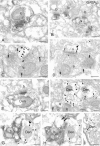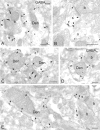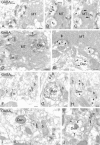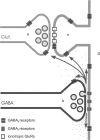Subcellular localization of metabotropic GABA(B) receptor subunits GABA(B1a/b) and GABA(B2) in the rat hippocampus
- PMID: 14657159
- PMCID: PMC6741037
- DOI: 10.1523/JNEUROSCI.23-35-11026.2003
Subcellular localization of metabotropic GABA(B) receptor subunits GABA(B1a/b) and GABA(B2) in the rat hippocampus
Abstract
Metabotropic GABA(B) receptors mediate slow inhibitory effects presynaptically and postsynaptically. Using preembedding immunohistochemical methods combined with quantitative analysis of GABA(B) receptor subunit immunoreactivity, this study provides a detailed description of the cellular and subcellular localization of GABA(B1a/b) and GABA(B2) in the rat hippocampus. At the light microscopic level, an overlapping distribution of GABA(B1a/b) and GABA(B2) was revealed in the dendritic layers of the hippocampus. In addition, expression of the GABA(B1a/b) subunit was found in somata of CA1 pyramidal cells and of a subset of GABAergic interneurons. At the electron microscopic level, immunoreactivity for both subunits was observed on presynaptic and, more abundantly, on postsynaptic elements. Presynaptically, subunits were mainly detected in the extrasynaptic membrane and occasionally over the presynaptic membrane specialization of putative glutamatergic and, to a lesser extent, GABAergic axon terminals. Postsynaptically, the majority of GABA(B) receptor subunits were localized to the extrasynaptic plasma membrane of spines and dendritic shafts of principal cells and shafts of interneuron dendrites. Quantitative analysis revealed enrichment of GABA(B1a/b) around putative glutamatergic synapses on spines and an even distribution on dendritic shafts of pyramidal cells contacted by GABAergic boutons. The association of GABA(B) receptors with glutamatergic synapses at both presynaptic and postsynaptic sides indicates their intimate involvement in the modulation of glutamatergic neurotransmission. The dominant extrasynaptic localization of GABA(B) receptor subunits suggests that their activation is dependent on spillover of GABA requiring simultaneous activity of populations of GABAergic cells as it occurs during population oscillations or epileptic seizures.
Figures








References
-
- Baude A, Nusser Z, Roberts JD, Mulvihill E, McIlhinney RA, Somogyi P ( 1993) The metabotropic glutamate receptor (mGluR1 alpha) is concentrated at perisynaptic membrane of neuronal subpopulations as detected by immunogold reaction. Neuron 11: 771-787. - PubMed
-
- Bischoff S, Leonhard S, Reymann N, Schuler V, Shigemoto R, Kaupmann K, Bettler B ( 1999) Spatial distribution of GABABR1 receptor mRNA and binding sites in the rat brain. J Comp Neurol 412: 1-16. - PubMed
-
- Bowery NG, Brown DA ( 1997) The cloning of GABAB receptors. Nature 386: 223-224. - PubMed
-
- Bowery NG, Hudson AL, Price GW ( 1987) GABAA and GABAB receptor site distribution in the rat central nervous system. Neuroscience 20: 365-383. - PubMed
Publication types
MeSH terms
Substances
LinkOut - more resources
Full Text Sources
Molecular Biology Databases
Miscellaneous
